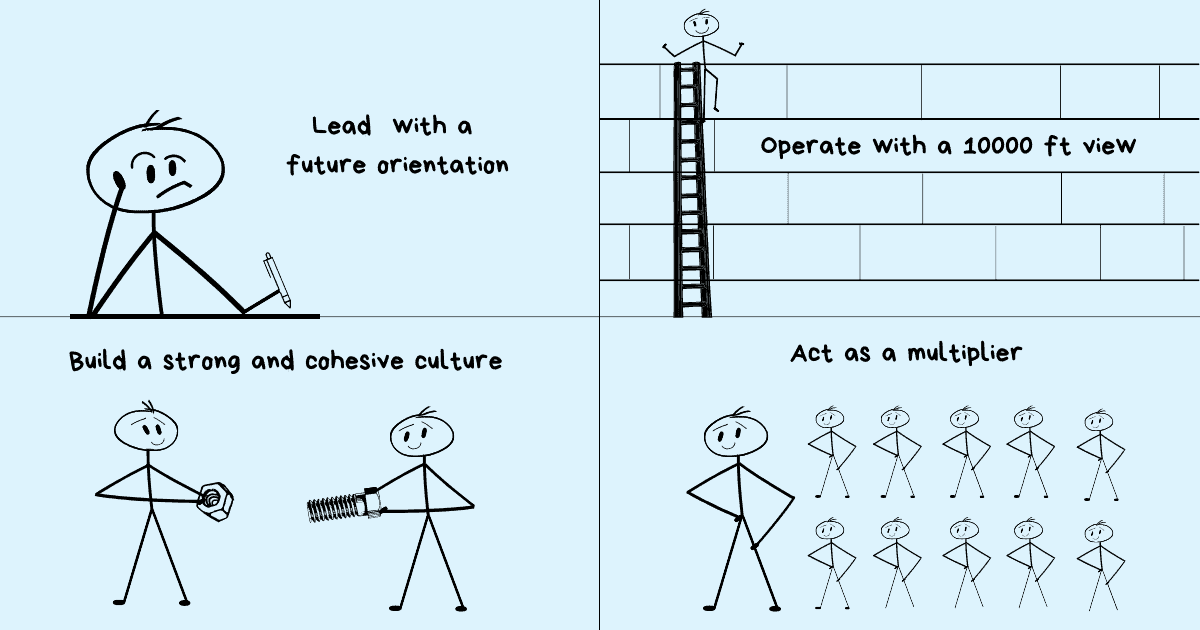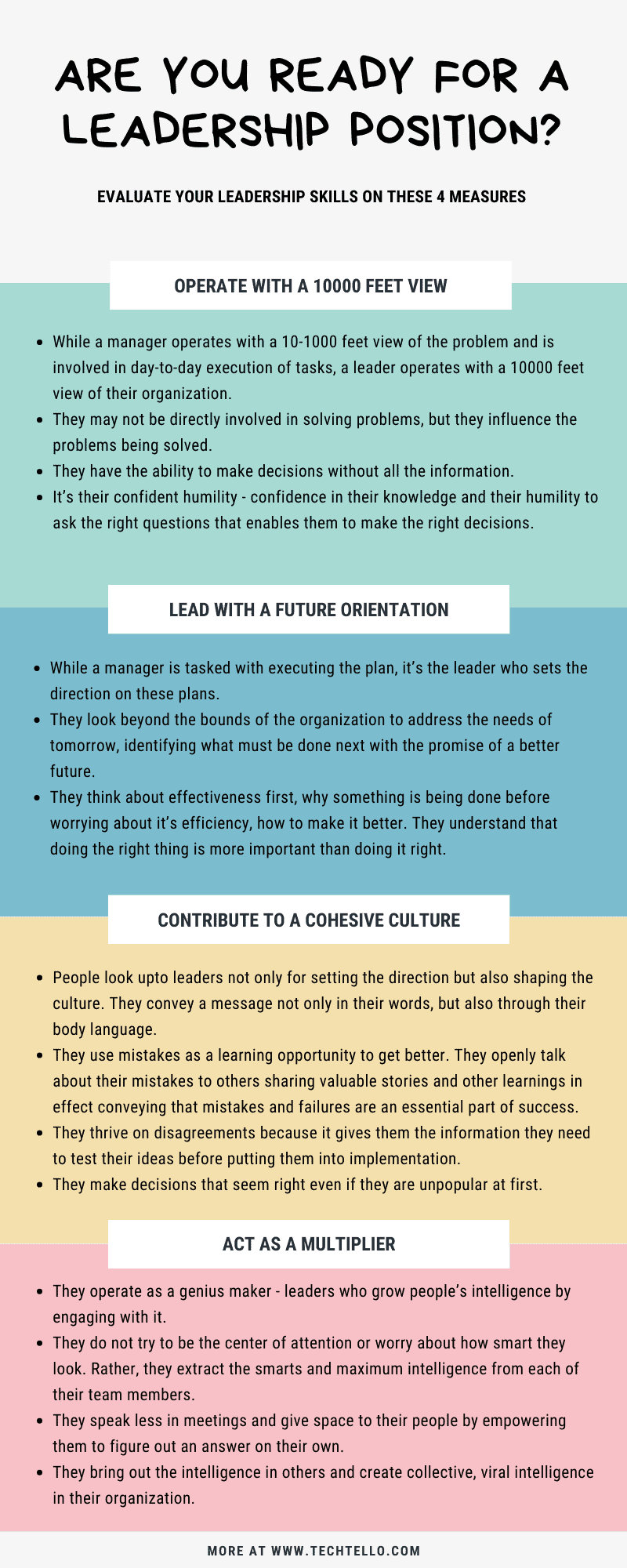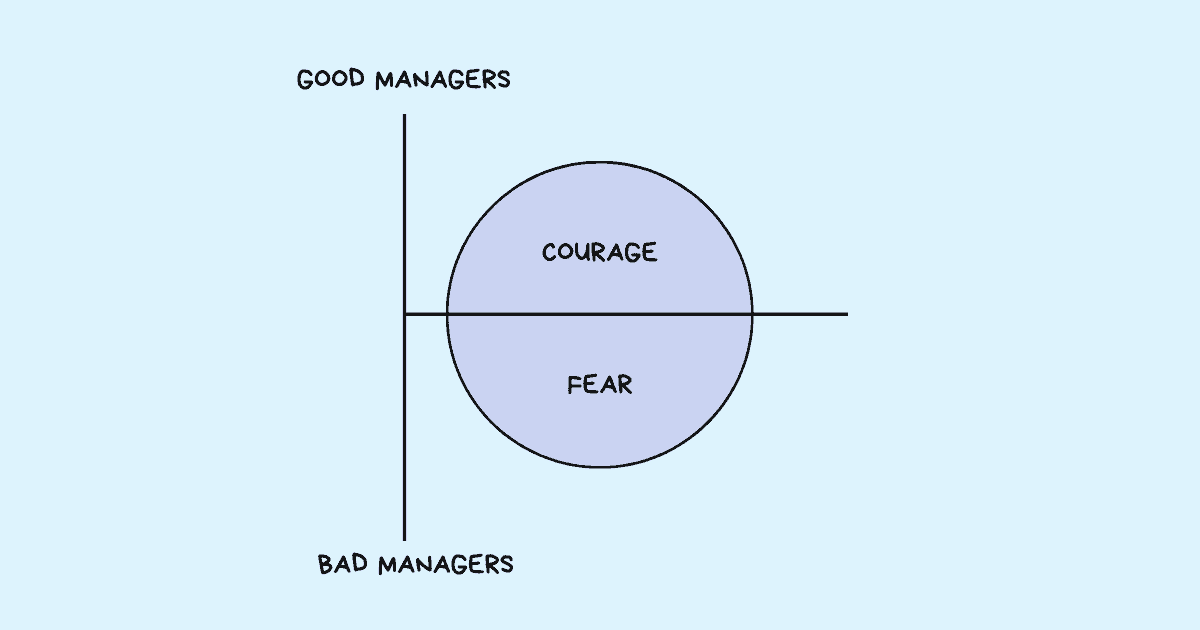Are You Ready for a Leadership Position?

I have worked with some excellent managers, people who were not only good at what they did, but also had great leadership potential. Sadly though, these managers didn’t invest in their own growth. They were so busy attending to the daily demands of the management job – putting out fires, resolving production issues, solving for customer escalation, moving from one delivery timeline to another – that they failed to build the skills required to become a great leader some day.
Like many managers in their position, they kind of assumed that by doing their job fairly well and staying in it for too long, they will automatically earn the leadership title. And I don’t blame them for this kind of thinking. For years, we have seen leaders rise through the ranks of the corporate ladder who had no business to be in those positions. When you see examples of bad leadership all around you, it’s kind of easy to assume you can be a leader too – after all, you consider yourself better than them. If they can be in those positions, you can be too. If they can jump through a fire hoop, you can jump too.
But is it the right kind of thinking for people of such great potential? By comparing themselves to people they do not aspire to become, these managers weren’t signing up for excellence, they had already accepted mediocrity.
They failed to realize that being a leader isn’t an extension of their current role, it’s a completely different ball game. It isn’t reflected in the title. It’s in the way they think, act and lead. Leaders need a high degree of self-awareness – ability to see their blind spots, accept holes in their knowledge and shun their years of thinking as a manager to give way to thinking like a leader. To get better, they need to study and practice the skills, knowledge, behaviours and actions of truly great leaders. It’s the commitment to improve and the determination to get better that makes a leader truly stand out.
Any manager looking to grow into a leader needs to do a self-evaluation of their skills to the demands of the role. It’s only by staying true to yourself, you can embrace the role with openness and curiosity. Developing your leadership style is always going to be a work in progress. There’s no end state. There’s always more to learn. But recognising a few essential traits can get you started and help you identify if you are ready for the role.
Before you approach your manager ready to tell your story, make sure you have the right story to tell. Management skills are often mistaken for leadership skills. Don’t make that mistake.
How to know if you are ready for a leadership position
Evaluate your leadership skills on these 4 measures:
1. Operate with a 10000 ft view
While a manager operates with a 10-1000 feet view of the problem and is involved in day-to-day execution of tasks, a leader operates with a 10000 feet view of their organization. They may not be directly involved in solving problems, but they influence the problems being solved. They practice effective listening, constantly ask questions and encourage others to question too:
Are we solving the right problem?
What’s our criteria to identify where our energy and effort must be spent?
How do we ensure other people are asking these questions too?
Instead of attacking the tip of the iceberg which is the symptom, they guide their people to find the underlying root cause by looking below the surface. While they cannot be aware of all the problems that impact their organization, they have a keen eye for the real issues that demand and deserve their attention.
Another important aspect of operating with a 10000 ft view is their ability to make decisions without all the information. They may not have all the details of the new product line, but have the experience to invest in a promising high level idea. They may not know the entire product development effort, but have the ability to do a rough estimation to determine if it’s worthwhile to invest. They may not know the ins and outs of a new technology, but have the technical aptitude to find the right technology fit for their organization.
It’s their confident humility – confidence in their knowledge and their humility to ask the right questions that enables them to make the right decisions or as Adam Grant describes it in Think Again “having faith in their capability while appreciating that they may not have the right solution or even be addressing the right problem. That gives them enough doubt to reexamine their old knowledge and enough confidence to pursue new insights.”
Ask these questions to evaluate yourself on this competency:
- Do I have the relevant experience to make decisions without complete information. Are there projects and examples where I have demonstrated this ability?
- If I am not involved in day-to-day operations, how can I influence my team to solve the right problems. Have I tried any strategies to make this work?
- What challenges did I face while building this skill and what did I learn?
- What gaps do I have to improve this skill?
- How do I plan to improve this skill – clearly articulate the steps you need to take.
Write down your response to each of these questions and do a true self-analysis of where you stand. Remember, even if you are really good at this skill, there’s always more to learn. You can always do better. This in no way means that you can’t take on a leadership role without perfecting this skill. However, the amount of work ahead of you will help you make the right decision for yourself.
On a scale of 1-10, how would you rate yourself on this competency. Collect this data from other senior people in the organization who have worked closely with you, even your manager. How do they rate you?
2. Lead with a future orientation
While a manager is tasked with executing the plan, it’s the leader who sets the direction on these plans.
They look beyond the bounds of the organization to address the needs of tomorrow, identifying what must be done next with the promise of a better future. They think about effectiveness first, why something is being done before worrying about it’s efficiency, how to make it better. They understand that doing the right thing is more important than doing it right.
As Peter Drucker writes in Effective Executive “Intelligence, imagination, and knowledge are essential resources, but only effectiveness converts them into results. By themselves, they only set limits to what can be attained. To be reasonably effective it is not enough for the individual to be intelligent, to work hard, or to be knowledgeable. Effectiveness is something separate, something different. But to be effective also does not require special gifts, special aptitude, or special training. Practice effectiveness until it becomes a habit. Effectiveness can be learned—and it also has to be learned.”
Future oriented forward thinking guides how leaders think and act – deciding the new initiatives to launch, identifying the projects that aren’t generating value and must be killed, ideas that require a new strategy to execute, challenges that must be addressed with creativity and innovation, conflicts that need to be resolved now before they are too difficult to handle, and decisions that require a fresh perspective.
Their thinking isn’t limited to new product initiatives. They also decide how the organization needs to scale to handle tomorrow’s demand. What should be the structure of the organisation for maximum operational effectiveness. What kind of people they need to hire to fill the knowledge and experience gap.
Ask these questions to evaluate yourself on this competency:
- What kind of strategy decisions have I made in the past? How did they turn out?
- Where do I spend most of my time – in day-to-day execution or thinking about the future?
- What kind of initiatives have I taken that contributed to organization growth?
- How do I find the right balance of effectiveness (doing the right thing) and efficiency (doing it right)?
- What has been my learning experience while building this skill?
- What mistakes have I made in the past and what steps can I take to improve this skill?
Write down your response to each of these questions and do a true self-evaluation. Once again rate yourself on a scale of 1-10 and collect this data from other senior people in your organization, even your manager. How do they rate you?
3. Contribute to a strong and cohesive culture
People look upto leaders not only for setting the direction but also shaping the culture. They convey a message not only in their words, but also through their body language – facial expressions, hand gestures and eye movements.
How do they react when someone makes a mistake?
- Bad leaders show their frustration, get angry, roll their eyes, blame others and express their disappointment in effect conveying that mistakes aren’t acceptable. They create a culture in which employees avoid challenges, play safe and hide their mistakes.
- Good leaders use mistakes as a learning opportunity to get better. They openly talk about their mistakes to others sharing valuable stories and other learnings in effect conveying that mistakes and failures are an essential part of success. They create a culture in which people innovate and experiment and use their failures as a sign to implement new strategies.
How do they handle disagreements?
- Bad leaders tie their ideas to their identity. They discourage dissent and reject ideas and opinions that contradict with their point of view. They create a culture in which people keep their heads down and do not feel safe to express their opinion. Employees do not raise their hands to ask questions, share an idea or otherwise express disagreement leading to groupthink.
- Good leaders embrace disagreements. They thrive on disagreements because it gives them the information they need to test their ideas before putting them into implementation. They create a culture in which people feel psychologically safe to share their viewpoint and value differences of opinions. As Amy Edmondson puts it in The Fearless Organization “Speaking up is only the first step. The true test is how leaders respond when people actually do speak up. Stage setting and inviting participation indeed build psychological safety. But if a boss responds with anger or disdain as soon as someone steps forward to speak up about a problem, the safety will quickly evaporate. A productive response must be appreciative, respectful, and offer a path forward.”
How do they make decisions?
- Bad leaders go with popular decisions or decisions that make them look good. Instead of using a framework for making good decisions and eliminating bad ones, they rely on judgments and intuitions. They create a culture in which expert intuitions lead to one disaster after another.
- Good leaders have the courage to be disliked. They make decisions that seem right even if they are unpopular at first. Instead of letting hierarchy bottleneck decision making, they encourage everyone to involve people who have the right information to help make the best decision. Instead of acting as a know-it-all, they lead with vulnerability by saying “I don’t know.” These simple words invite others to make positive contributions to the decision process thereby breaking down siloed thinking in their organization to give way to collaborative thinking for better decision-making.
Ask these questions to evaluate yourself on this competency:
- What positive contributions have I made to the culture of my organization?
- What message did I convey about mistakes and failures to my people?
- Do I encourage others to disagree with me? When was the last time someone disagreed with me. How did I handle it?
- What’s my framework for making better decisions? How do I encourage collaborative thinking in my organization?
- What gaps do I have to improve this skill?
- What mistakes have I made in the past and what steps can I take to make it better?
Write down your response to each of these questions and do a true self-evaluation. Once again rate yourself on a scale of 1-10 and collect this data from other senior people in your organization, even your manager. How do they rate you?
4. Act as a multiplier
In Multipliers, Liz Wiseman describes two types of leaders – the Multiplier and the Diminisher.
She calls Multipliers as the genius maker – leaders who grow people’s intelligence by engaging with it. These leaders do not try to be the center of attention or worry about how smart they look. Rather, they extract the smarts and maximum intelligence from each of their team members. They speak less in meetings and give space to their people by empowering them to figure out an answer on their own. They bring out the intelligence in others and create collective, viral intelligence in their organization.
She writes “they make everyone around them smarter and more capable. Multipliers invoke each person’s unique intelligence and create an atmosphere of genius—innovation, productive effort, and collective intelligence. Multipliers get more from their people because they are leaders who look beyond their own genius and focus their energy on extracting and extending the genius of others. And they don’t get just a little more back; they get vastly more. Multipliers not only access people’s current capability, they stretch it. They get more from people than they knew they had to give.”
The other type of leader, the Diminsher is a genius – this type of leader does all the thinking. They are very smart, but also have a way of shutting down people around them. They kill other people’s ideas, give a lot of feedback and do most of the talking. They make all the decisions by themselves and then announce those decisions to the organization. They have an answer for everything, are strongly opinionated and put all their energy into selling their ideas to others and convincing them to execute on the details. No one else’s opinion matters to them.
They hire intelligent people, but don’t give them permission to think for themselves. They tell others what to do, make all the important decisions, and jump in to take over when someone appears to be failing. They are so absorbed in their own intelligence, trying to be the smartest, most capable person in the room that they stifle other people’s intelligence and capability. They underutilize people and leave creativity and talent on the table.
She writes “The Diminisher’s view of intelligence is based on elitism and scarcity. Diminishers appear to believe that really intelligent people are a rare breed and that they are of that rare breed. From this assumption they conclude that they are so special, other people will never figure things out without them. Diminishers’ two-step logic appears to be that people who don’t “get it” now, never will; therefore, I’ll need to keep doing the thinking for everyone. In the Diminisher world, there is no vacation for the smart people!”
Ask these questions to evaluate yourself on this competency:
- What type of a leader are you – Multiplier or Diminisher?
- How much of your team’s intelligence do you draw out and put to use?
- What can you do to have better access to what other people know?
- What mistakes have you made in the past and what steps can you take to make this skill better?
Write down your response to each of these questions and do a true self-evaluation. Once again rate yourself on a scale of 1-10 and collect this data from your team, including your manager. How do they rate you?
By staying true to yourself while answering these questions, you can determine if you are ready for a leadership position or there’s more work ahead of you before deciding to take on the next level of responsibilities. High self-awareness with the willingness to identify gaps in your skills will help you make the right decision for yourself.
Summary
Evaluate your leadership skills on these four measures:
- Ability to make decisions with a 10000 ft view of your organization: Can you make decisions and guide your teams into solving the right problems even when you are not involved in day-to-day execution.
- Lead with a future orientation: How do you use your strategic thinking skills to identify new initiatives that will determine the future of your organization. How do you contribute to hiring and organizational structural planning.
- Contribute to a strong culture: How does your behaviour and actions contribute to the positive culture of your organization. How do you see others around you behave and act.
- Act as a multiplier: How do you build critical thinking skills in your organization and empower your teams thereby utilizing their talent and increasing their intelligence.






























